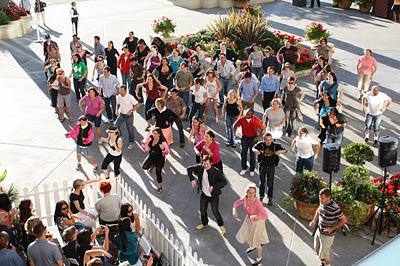Flash mob
A flash mob is a group of people who assemble suddenly in a public place, perform an unusual and sometimes seemingly pointless act for a brief time, then disperse, often for the purposes of entertainment, satire, artistic expression.Flash mobs are organized via telecommunications, social media, or viral emails.
It is worth noting that the key factors that distinguish a flash-mob and any other performance in a public place are: 1. Organisation: Flash-mobs are open social organisations, usually mobilised in virtual circles or through social networking. A performance is usually coordinated and led in a closed group, who practice together to achieve synchronisation in advance of the performance. 2. Participation: As the name indicates, a flash-mob must both be open to, and involve, members of the common public, whilst a performance may be merely limited to a specific practised group participation. 3. Motive: The motive for participation in a flash-mob is much similar to the motive behind authoring an article on Wikipedia. The participants are primarily motived to collaborate and co-create, without deriving any firm benefits, monetary or otherwise, from it. A performance on the other hand is carried out with foreseeable benefits in mind, ranging from recognition to monetary incentives.
The term, coined in 2003, is generally not applied to events and performances organized for the purposes of politics , commercial advertisement, publicity stunts that involve public relation firms, or paid professionals.In these cases of a planned purpose for the social activity in question, the term smart mobs is often applied instead.
First flash mob
One of the first flash mobs was created in Manhattan in May 2003, by Bill Wasik, senior editor of Harper's Magazine.The first attempt was unsuccessful after the targeted retail store was tipped off about the plan for people to gather. Wasik avoided such problems during the second flash mob, which occurred on June 3, 2003, at Macy's department store, by sending participants to preliminary staging areas – in four prearranged Manhattan bars – where they received further instructions about the ultimate event and location just before the event began.
More than 130 people converged upon the ninth floor rug department of the store, gathering around an expensive rug. Anyone approached by a sales assistant was advised to say that the gatherers lived together in a warehouse on the outskirts of New York, that they were shopping for a "love rug", and that they made all their purchase decisions as a group.Subsequently, 200 people flooded the lobby and mezzanine of the Hyatt hotel in synchronized applause for about 15 seconds, and a shoe boutique in SoHo was invaded by participants pretending to be tourists on a bus trip.
Wasik claimed that he created flash mobs as a social experiment designed to poke fun at hipsters and to highlight the cultural atmosphere of conformity and of wanting to be an insider or part of "the next big thing".The Vancouver Sun wrote, "It may have backfired on him ... [Wasik] may instead have ended up giving conformity a vehicle that allowed it to appear nonconforming." In another interview he said "the mobs started as a kind of playful social experiment meant to encourage spontaneity and big gatherings to temporarily take over commercial and public areas simply to show that they could".
Precedents and precursors
In 19th-century Tasmania, the term flash mob was used to describe a subculture consisting of female prisoners, based on the term flash language for the jargon that these women used. The 19th-century Australian term flash mob referred to a segment of society, not an event, and showed no other similarities to the modern term flash mob or the events it describes.
An early literary example can be found in a famous German novel for children by Erich Kästner. At the end of Emil and the Detectives (1929) the protagonist captures a thief by organizing a large crowd of children through a kind of self-organized intelligence service. The mob of children first drives the thief into a corner and then keeps him from escaping.
In 1973, the story "Flash Crowd" by Larry Niven described a concept similar to flash mobs.With the invention of popular and very inexpensive teleportation, an argument at a shopping mall—which happens to be covered by a news crew—quickly swells into a riot. In the story, broadcast coverage attracts the attention of other people, who use the widely available technology of the teleportation booth to swarm first that event—thus intensifying the riot—and then other events as they happen. Commenting on the social impact of such mobs, one character (articulating the police view) says, "We call them flash crowds, and we watch for them." In related short stories, they are named as a prime location for illegal activities (such as pickpocketing and looting) to take place.
Flash mobs began as a form of performance art.While they started as an apolitical act, flash mobs may share superficial similarities to political demonstrations. Flash mobs can be seen as a specialized form of smart mob, a term and concept proposed by author Howard Rheingold in his 2002 book Smart Mobs: The Next Social Revolution.









No comments:
Post a Comment